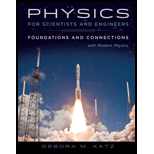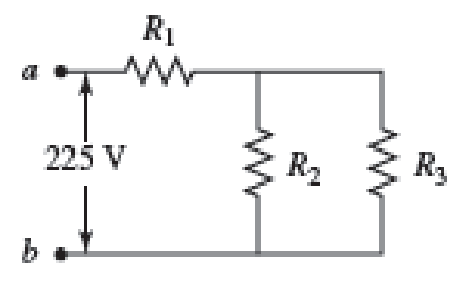
Three resistors with resistances R1 = R/2 and R2 = R3 = R are connected as shown, and a potential difference of 225 V is applied across terminals a and b (Fig. P29.49).
a. If the resistor R1 dissipates 75.0 W of power, what is the value of R?
b. What is the total power supplied to the circuit by the emf?
c. What is the potential difference across each of the three resistors?

(a)
Find the value of resistance from the given circuit.
Answer to Problem 49PQ
The value of
Explanation of Solution
Refer the figure
Write the equivalent resistance of the parallel circuit as.
Here
Since
Write the equivalent resistance of circuit as.
Here,
Write the expression for the current drawn by the circuit from the voltage applied as.
Here
Write the expression for power dissipated across
Here,
Conclusion:
Substitute
Rearrange the terms in above equation
Substitute
Substitute
Substitute
Rearrange the terms in above equation
Thus, the value of
(b)
Find the total power supplied to the circuit.
Answer to Problem 49PQ
The total power supplied to the circuit is
Explanation of Solution
The total power supplied to the circuit is given as
Here
Conclusion:
Substitute
Substitute
Thus, the total power supplied to the circuit is
(c)
Find the potential difference across the three resistors.
Answer to Problem 49PQ
The potential difference across the resistance
Explanation of Solution
Write the expression for the potential difference across the resistance
Here
Write the expression for the remaining potential drop is across the parallel combination of
Here
Conclusion:
Substitute
Substitute
Thus, the potential difference across the resistance
Want to see more full solutions like this?
Chapter 29 Solutions
Webassign Printed Access Card For Katz's Physics For Scientists And Engineers: Foundations And Connections, 1st Edition, Single-term
- No chatgpt pls will upvote Already got wrong chatgptarrow_forwardA hydrogen atom has just a single electron orbiting the nucleus, which happens to be a single proton without any neutrons. The proton is positively charged, the electron negatively, but both with the same magnitude of charge given by e=1.602x10-19C. The mass of an electron is 9.11x10-31kg, and the proton is 1.67x10-27kg. Find the ratio of the electrostatic to the gravitational force of attraction between the electron and the proton in hydrogen. \arrow_forwardWhat is the third law pair to the normal force as you sit in a chair? What effect does the sun's pull on earth have in terms of third law pairs?arrow_forward
- Using Newton's 2nd law, show that all objects subject to the pull of gravity alone should fall at the same rate. What is that rate?arrow_forwardNo chatgpt pls will upvotearrow_forwardA cart on wheels (assume frictionless) with a mass of 20 kg is pulled rightward with a 50N force. What is its acceleration?arrow_forward
- Light travels through a vacuum at a speed of 2.998 x 108m/s. Determine the speed of light in the following media: crown glass (n = 1.52)arrow_forward2.62 Collision. The engineer of a passenger train traveling at 25.0 m/s sights a freight train whose caboose is 200 m ahead on the same track (Fig. P2.62). The freight train is traveling at 15.0 m/s in the same direction as the passenger train. The engineer of the passenger train immediately applies the brakes, causing a constant acceleration of 0.100 m/s² in a direction opposite to the train's velocity, while the freight train continues with constant speed. Take x = 0 at the location of the front of the passenger train when the engineer applies the brakes. (a) Will the cows nearby witness a collision? (b) If so, where will it take place? (c) On a single graph, sketch the positions of the front of the pas- senger train and the back of the freight train.arrow_forwardCan I get help with how to calculate total displacement? The answer is 78.3x-4.8yarrow_forward
- 2.70 Egg Drop. You are on the Figure P2.70 roof of the physics building, 46.0 m above the ground (Fig. P2.70). Your physics professor, who is 1.80 m tall, is walking alongside the building at a constant speed of 1.20 m/s. If you wish to drop an egg on your profes- sor's head, where should the profes- sor be when you release the egg? Assume that the egg is in free fall. 2.71 CALC The acceleration of a particle is given by ax(t) = -2.00 m/s² +(3.00 m/s³)t. (a) Find the initial velocity Vox such that v = 1.20 m/s 1.80 m 46.0 marrow_forwardOne has to push down a ball with a force of 470 Newtons in order to hold the ball still, completely submerged under the surface of the water. What is the volume of the styrofoam ball in cubic meters? Use 997 kg/m3 as the density of water, 95 kg/m3 for the density of the styrofoam, and g = 9.8 m/s2.arrow_forwardThe cube is placed in a bucket of water and find that it floats, with 33% of its volume submerged below the surface of the water. What is the density of the mystery material? The material is uniformly distributed throughout the solid cube, with the number of kg/m3.arrow_forward
 Physics for Scientists and Engineers: Foundations...PhysicsISBN:9781133939146Author:Katz, Debora M.Publisher:Cengage Learning
Physics for Scientists and Engineers: Foundations...PhysicsISBN:9781133939146Author:Katz, Debora M.Publisher:Cengage Learning
 Physics for Scientists and EngineersPhysicsISBN:9781337553278Author:Raymond A. Serway, John W. JewettPublisher:Cengage Learning
Physics for Scientists and EngineersPhysicsISBN:9781337553278Author:Raymond A. Serway, John W. JewettPublisher:Cengage Learning Physics for Scientists and Engineers with Modern ...PhysicsISBN:9781337553292Author:Raymond A. Serway, John W. JewettPublisher:Cengage Learning
Physics for Scientists and Engineers with Modern ...PhysicsISBN:9781337553292Author:Raymond A. Serway, John W. JewettPublisher:Cengage Learning Physics for Scientists and Engineers, Technology ...PhysicsISBN:9781305116399Author:Raymond A. Serway, John W. JewettPublisher:Cengage Learning
Physics for Scientists and Engineers, Technology ...PhysicsISBN:9781305116399Author:Raymond A. Serway, John W. JewettPublisher:Cengage Learning Principles of Physics: A Calculus-Based TextPhysicsISBN:9781133104261Author:Raymond A. Serway, John W. JewettPublisher:Cengage Learning
Principles of Physics: A Calculus-Based TextPhysicsISBN:9781133104261Author:Raymond A. Serway, John W. JewettPublisher:Cengage Learning





